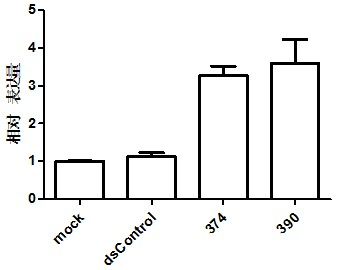Application of small activating RNA (Ribonucleic Acid) of INTS6 (Homo Sapiens Integrator Complex Subunit 6) gene to preparation of prostate cancer fighting medicament
An INTS6, prostate cancer technology, applied in gene therapy, drug combination, anti-tumor drugs, etc., can solve the problem of expression loss, and achieve the effect of exact activation, low cost and safe application
- Summary
- Abstract
- Description
- Claims
- Application Information
AI Technical Summary
Problems solved by technology
Method used
Image
Examples
Embodiment 1
[0021] Example 1 dsRNAs up-regulate the expression of INTS6 gene in prostate cancer cells
[0022] Experimental program:
[0023] 1. Cell lines: human hormone-independent prostate cancer cell lines PC3, Du145 (Shanghai Cell Institute)
[0024] 2. Synthesis of dsRNAs: dsRNAs were chemically synthesized by Shanghai Jikai Biotechnology Co., Ltd.
[0025] 3. Experimental group:
[0026] 20nM dsINTS6-374 and -390 groups, nonsense dsRNA control group (dsControl) and blank transfection reagent group (mock). dsControl group dsRNA is non-homologous to known human genome sequence: sense strand, 5'-ACU ACU GAG UGA CAG UAG A[dTdT]-3' (SEQ ID NO:5); antisense strand, 5'-UCU ACU GUC ACU CAG UAG U[dTdT]-3' (SEQ ID NO: 6).
[0027] 4. Cell culture and transfection:
[0028] The cells were cultured in RPMI1640 medium containing 10% inactivated newborn bovine serum, placed in a 37oC cell culture box with a CO2 content of 5%. The day before transfection, the cells were subcultured and ...
Embodiment 2
[0038] Example 2 Inhibitory effect of dsINTS6-374 / -390 up-regulating INTS6 on hormone-independent prostate cancer cells in vitro
[0039] Experimental program:
[0040] 1. Cell line: same as Example 1.
[0041] 2. dsRNAs synthesis: with embodiment 1.
[0042] 3. Experimental grouping: with embodiment 1.
[0043] 4. Cell culture and transfection: the same as in Example 1.
[0044] 5. Tetrazolium salt (MTT) colorimetric method:
[0045] Take the cancer cells in the logarithmic growth phase, trypsinize to make a single cell suspension, and plant the cells in a 96-well culture plate at a density of 2000-5000 cells per well (to ensure the accuracy of the results, the The cell attachment rate, doubling time and the growth curve of cells with different inoculated numbers, and then determine the inoculated number of cells in each well to ensure that the cells will not be overfilled when the culture is terminated), and the culture plate is placed at 37 o C, 5% CO 2 After culturin...
Embodiment 3
[0061] Example 3 dsINTS6-374 up-regulates INTS6 to inhibit the growth of hormone-independent prostate cancer in vivo
[0062] Experimental program:
[0063] 1. Cell line: human hormone-independent prostate cancer cell line PC3.
[0064] 2. Animal model: 4-week-old BALB-c nude mice were used to bear tumors subcutaneously. After tumor formation, they were divided into non-sense dsRNA control group and dsINTS6-374 / -390 RNA group for intervention, with 4 rats in each group.
[0065] 3. Dosing regimen: intratumoral injection of 30 μg of liposome-coated RNA, once every 3 days, for a total of three weeks.
[0066] 4. Observation of results: Synchronous observation of tumor size changes. Finally, nude mice were sacrificed, and the expression of INTS6 protein in tumor tissues was observed by immunohistochemical staining.
[0067] The result is as follows:
[0068] Small activating RNA can activate the expression of INTS6 in subcutaneous xenografts of PC3 nude mice, and at the same...
PUM
 Login to View More
Login to View More Abstract
Description
Claims
Application Information
 Login to View More
Login to View More - R&D
- Intellectual Property
- Life Sciences
- Materials
- Tech Scout
- Unparalleled Data Quality
- Higher Quality Content
- 60% Fewer Hallucinations
Browse by: Latest US Patents, China's latest patents, Technical Efficacy Thesaurus, Application Domain, Technology Topic, Popular Technical Reports.
© 2025 PatSnap. All rights reserved.Legal|Privacy policy|Modern Slavery Act Transparency Statement|Sitemap|About US| Contact US: help@patsnap.com



